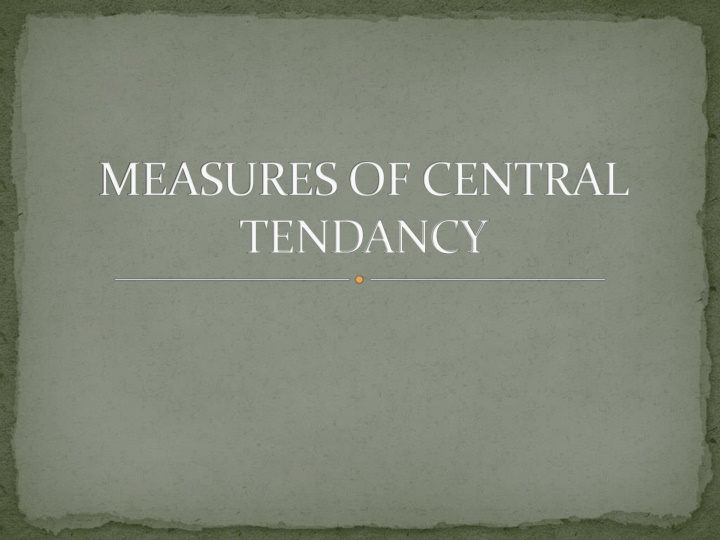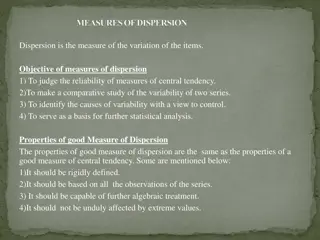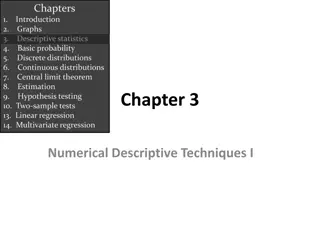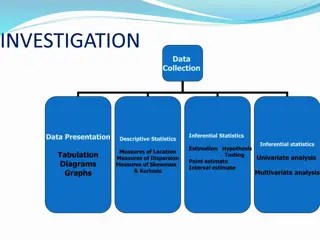Measures of Central Tendancy
Central tendancy measures such as average, arithmetic mean, and methods for calculating mean in individual and discrete series are discussed in this content. Learn about the characteristics of a good average and different types of averages like arithmetic mean, geometric mean, harmonic mean, median, and mode. Explore direct and shortcut methods for finding arithmetic mean in various scenarios.
Download Presentation

Please find below an Image/Link to download the presentation.
The content on the website is provided AS IS for your information and personal use only. It may not be sold, licensed, or shared on other websites without obtaining consent from the author.If you encounter any issues during the download, it is possible that the publisher has removed the file from their server.
You are allowed to download the files provided on this website for personal or commercial use, subject to the condition that they are used lawfully. All files are the property of their respective owners.
The content on the website is provided AS IS for your information and personal use only. It may not be sold, licensed, or shared on other websites without obtaining consent from the author.
E N D
Presentation Transcript
MEASURES OF CENTRAL TENDANCY
AVERAGE Average is a single value which is the representative of whole data i.e. the value which describe the whole figures of the observation It lies between the two extreme of the series. CHARACTERISTIC OF A GOOD AVERAGE : Must be rigidly defined . Should be based on all observation. * It should be easily understood. Should be capable of further algebraic calculations. * It should not affected by extreme values. It should have sampling stability. *
TYPES OF AVERAGES The following are the important types of averages : A)Mathematical Averages Arithmetic mean Geometric mean Harmonic mean B)Positional Averages Median Mode
ArithmeaticMean The arithmetic mean is defined as being equal to the sum of the numerical values of the observation divided by the total number of observation. CALCULATION OF ARITHMETIC MEAN (IN CASE OF INDIVIDUAL SERIES) Lets take an example: Calculate the arithmetic mean of the marks obtained by a group of 10 students. Individual marks obtained are as follows: Student 1 2 3 4 5 6 7 8 9 10 Marks 20 48 39 51 45 69 54 29 60 35
There are two methods for finding arithmetic mean in case of individual series DIRECT METHOD SHORT CUT METHOD Mean= X/N Mean= A+ d/N Where A is Assumed Mean and D= X-A In the above question: Let A =39 D or (X-A)= 60 =39 + 60/10 =39+6 =45 X X-A 20 -19 Where X is sum of all observation & N is number of observation. In the above question ; 20+48+39+51+45+69+54+29+60+35 10 =450/10 =45 48 9 39 0 51 12 45 6 69 30 54 15 29 -10 60 21 35 -4
Calculation of Arithmetic mean in case of discrete series Discrete series means where frequencies of a variable are given without giving class interval There are two methods of calculating mean; Direct Method Mean = f x / f Short cut Method Mean =A+ f d x / f Question: Calculate A.M. from the following data Marks Obtained 4 8 12 16 20 No.Of Students 6 12 18 15 9
Direct Method x f fx Dx(X-A) fdx 4 6 24 -8 -48 8 12 96 -4 -48 12 18 216 0 0 16 15 240 4 60 20 09 180 8 72 f=60 fx=756 dx=0 fdx=36
Direct Method : Mean= 756/60 =12.6 Short Cut Method: A+ fdx / f =12+36/60 (putting values in formula) =12+0.6 =12.6























